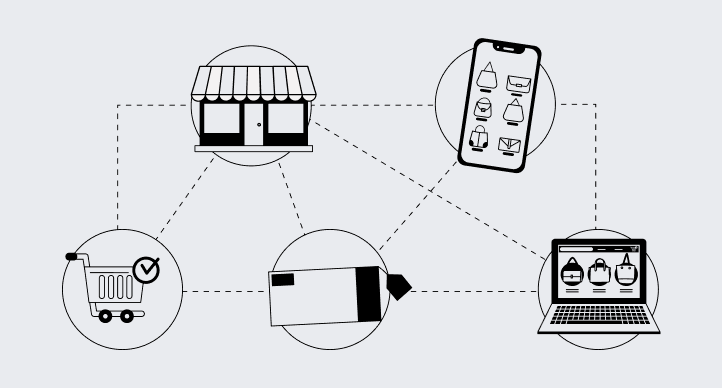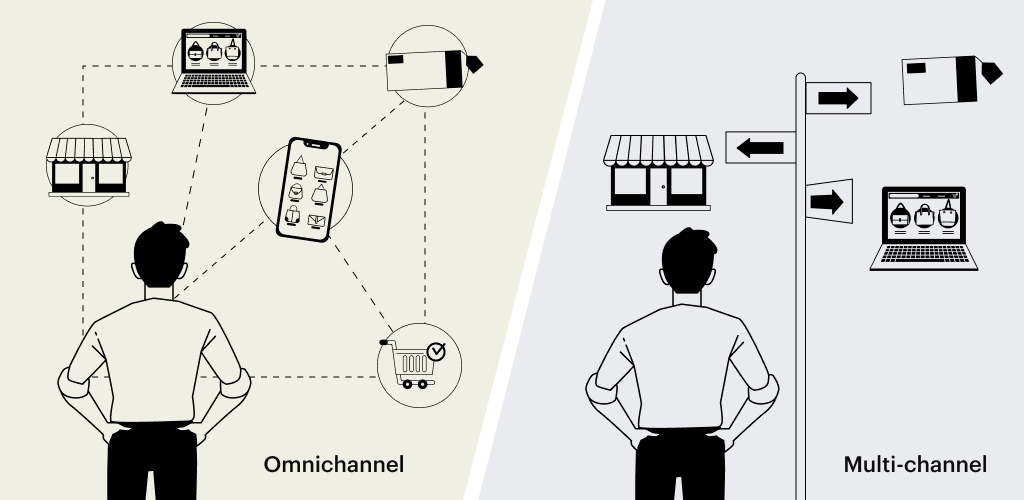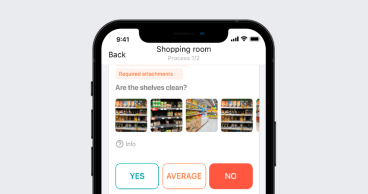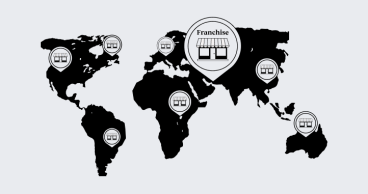Qvalon Blog article content
By: Jul Domingo
Accessibility is the driving force for omnichannel retail. It's the logical response to the consumers' desire for a more comprehensive shopping experience.
Just think about it, how often do you look for information on the internet before making a purchase?

But hey, you're not the only one. Google, Ipsos MediaCT, and Sterling Brands recently conducted a study that revealed 75% of shoppers are more likely to visit a store if they find retail information online.
And according to TrueCommerce CTO, Peter Spellman: "Consumers have been asking for omnichannel experiences for years."
Tim Ceci, a retail consultant for major brands, also says much of this has to do with customers having grown more diverse and evolved. "Customers now have more choices in which to explore, shop & return now more than ever, such as online, inshore, pop up, event, resale, and so on," he adds.
During the height of the pandemic, we've seen how important it is to be where your customers are. As a result, physical stores have had to close or cut operations. And most business owners found that going digital was a smart move to reach out to their customers. In fact, e-commerce's market share grew from 14% in 2019 to about 17% in 2020.
Even as the economy gradually recovers, modern shoppers are still prioritizing convenience above all else.
But it isn't just about moving online for physical retailers or going brick-and-mortar for e-commerce merchants.
It's about being available on various channels to make the shopping experience as convenient as possible for your customers.
This post will discuss the benefits of seamless integration between your online and offline channels and offer a few examples of real-life omnichannel strategies.
What is Omnichannel Retail?
Omnichannel retail is a business model that delivers a seamless customer experience through various channels, such as mobile devices, laptops, and physical retail.
All these channels come together to ensure your shoppers can move from one platform to another wherever they are in their customer journey.
With omnichannel retail, you're adapting to your customers' own shopping routines by serving them where they are. This is a power that wasn't available for retail and eCommerce merchants before. As a result, they have to wait until customers come to them. But omnichannel retail is changing the game.
"There is no "retail" without "omnichannel." 10 years ago, an omnichannel strategy felt new because legacy retailers were playing catch up. Today, retailers begin with an omnichannel approach. There is no other way."
- Joe Skorupa, Editor at Large for RIS News
According to Bizibl marketing, you only have 30 seconds or less to hook the customers in. This proves that the average consumer is prone to distraction.
In today's world, Omnichannel Retail, or Omnichannel commerce, is one of the best and most innovative ways to keep your shoppers' attention alive.
It isn't just a buzzword. The reason you're hearing it a lot is that it's exactly what most businesses need these days.
Understanding differences between multi-channel and omnichannel retail
Multi-channel and omnichannel retail have one thing in common—they both use various distribution channels.
This similarity tends to introduce a lot of confusion between the two.

Multi-channel commerce is a common practice among retailers. Consumers can interact with brands across different channels, but each experience is unique. The journey starts and ends on one channel.
It's like a flower. Every petal stands on its own regardless of the presence or absence of another.
Omnichannel retail, on the other hand, is like a web. Each channel is linked together, making it difficult to tell them apart. That's why for retailers, the line between online and offline touchpoints is blurred.
Omnichannel bridges all these channels together to form a unified experience. Customers can begin shopping on their desktops and end up making their purchases in stores. With everything interconnected, it's easier and smoother for retailers to make a sale.
To put it simply, omnichannel operations focus on the entire customer experience instead of the individual experiences on various channels.
Why is omnichannel important for retailers?
Having a strong omnichannel retail strategy isn't entirely for the benefit of your customers. In fact, businesses have so much more to gain, such as:
-
Improved customer experience and satisfaction
-
Increased visibility
-
Boost in sales and traffic
-
Better customer insights
-
Greater brand awareness
Improved customer experience and satisfaction. Giving a fluid and flexible experience will make you more popular with your target market - it's one of the benefits of omnichannel retail. In fact, omnichannel has a 90% higher retention rate than single-channel.
Increased visibility. If your consumers can't find you where you are, you instantly bring their shopping journey to a halt. Implementing omnichannel retail strategies allows businesses to create more accessible touchpoints for their target audience.
Boost in sales and traffic. With omnichannel retailing, you can experience an increase in your online and offline sales and traffic. The Aberdeen Group found out that companies with high customer omnichannel engagement saw a 9.5% annual revenue increase.
Better customer insights. Tracking customer behavior across multiple channels helps retailers provide more personalized service to their consumers. An independent study from Linnworks found that 51% of consumers find personalization appealing.
Greater brand awareness With an effective omnichannel retail strategy, you don't have to market your brand so hard - your customers will do it for you. A staggering 78% of people regularly talk about their favorite recent experiences with others.
This increase in touchpoints calls for a smoother integration. Consumers get to interact with brands more freely by removing the barriers separating business channels.
Marketing Week reported that in the late '90s or early 2000s, most consumers used two touchpoints to complete a transaction, and only 7% needed four. Since then, the times have changed.
Nowadays, Rain Group's sales prospecting research finds that it takes eight touchpoints to secure an initial meeting with a new customer or guarantee any conversion.
"The idea of omnichannel comes down to creating a brand presence wherever your customers are, on or offline. In doing so, retailers have created even stronger relationships with their customers while giving them more ways to shop."
- Peter Spellman, TrueCommerce Founder
Learn from the best omnichannel retailers
To understand what omnichannel experience is like, let's look at the following omnichannel retail examples. We've split this section up into two parts: physical retailers and eCommerce businesses.
Large Retailers
It's no surprise large retailers are leading the trend. They have all the necessary tools to provide a premium omnichannel shopping experience, after all. "They have the store footprint, solid online stores, plus apps and a variety of fulfillment options for customers," Spellman described. Let's look at two of the best omnichannel retailers: Walmart and Target.
Online and Mobile Channels: Walmart
Walmart established its omnichannel presence very early on. In 2016, the retail giant purchased Jet.Com, an eCommerce company with a mobile app.
This enabled Walmart to gain access to the platform, which offers discounts and shipping on everything from groceries to electronics through its website and app. As a result, Walmart was able to cater to their consumers online, via an app, and in their stores right off the bat.
Here’s also another reason Walmart is considered a pioneer in Omnichannel Retail:

Source: Twitter
Delivery and pick-up: Target
When it comes to omnichannel retailing, Target isn't far behind. The company acquired Shipt, a delivery service company, in 2017, which has enabled them to level up their delivery and pick-up services. Target's online sales soar with this fulfillment strategy and exceptional omnichannel retail experience, allowing it to compete with marketplaces and eCommerce sites.
Target's effective data acquisition accelerated its private-label business. "Target crunched numbers from all of its channels to create new in-house brands, 10 of which now have more than $1 billion in annual sales. You can't do that without being a master of omnichannel retailing," Skorupa commented. This makes them one of the best omnichannel retailers to learn from.
Product returns: Nordstrom
To pull off omnichannel retailing availability, Nordstrom expanded their business to eCommerce - a move that has been a huge success. "The company gets a third of their sales online," shares Tim Ceci, who served as a consultant for Nordstrom.
However, going eCommerce isn't the only reason Nordstrom is considered one of the best omnichannel retailers. Customer care is exemplary due to its omnichannel activities. For instance, it's very easy to return products to them. They give the customers the power to choose:
-
Take the item to the store
-
Drop it off for curbside pick-up
-
Send it back via email
This is what omnichannel customer experience is all about.
eCommerce Businesses
Not having a physical store isn't a hindrance to omnichannel retail. Omnichannel strategies are also alive and well in the online store realm.
"Omnichannel is important if you want to maximize your opportunities to make sales online as not all customers will buy or want to buy through your website."
- Elliott Davidson, Founder of Parcel Master
True enough, by expanding your reach into other possible channels, you'll have more ways to generate income. Plus, residing in the confines of the internet isn't an issue. There are many ways to bring your online shop to the real world.
Data collection and physical touchpoints: Amazon
More and more online-only shops are making ways to create physical touchpoints for their target audience. Take it from Amazon.
"Beyond the obvious information, they have a strong profit operation. The word is that Amazon will operate more retail stores in the future," shared Tim Ceci when asked what he thought were the best omnichannel retailers.
Retailers can take a page out of Amazon's book and start slow. If you're an eCommerce merchant, you can create opportunities for your customers to interact with you in the real world via pop-up shops and showrooms. Amazon, for instance, had 87 pop-up stores that the company used to test the waters.
There's a second reason the eCommerce giant is on the list: Amazon is also a boss in unifying users' information. Amazon Prime is a prime example of it. Most customer data, including behavior and past purchases, is isolated in each channel. With Amazon's single customer view, it's easy to capture each member's preferences and put the right products in front of them while delivering a wonderful omnichannel shopping experience.
Personalization: Warby Parker
The OG DTC brand Warby Parker, known for its eyeglasses, has successfully crossed over to physical retail. According to Ceci, "they have grown over the last ten years and found the right balance of stores and online business in which to drive sales/service."
Instead of multi-channel retailing, they decided on creating a comprehensive experience by creating an omnichannel strategy surrounding customer information. They developed a system that allowed sales associates to see what items customers have checked out/favorited on the app or online. The staff can assist them, help them, and close the sale more easily. On the other hand, if you've decided to put your purchase on hold while in-store, you can easily finish the deed on the app after you've made up your mind.
Should smaller retailers have an omnichannel strategy?
Absolutely! Aside from the benefits mentioned above, providing a great omnichannel shopping experience gives smaller retailers a lot of competitive advantage.
"We've also seen great omnichannel experiences from smaller brands and retailers," Spellman shares. "For example, when the pandemic hit, a lot of wineries had to close their tasting rooms and retail locations, so they developed online channels and options like wine clubs to fill the gap."
According to Spellman, all these ventures were tremendously successful. Many of them have continued to build their eCommerce presence and integrate it into their physical locations by using customer histories or offering wine club sign-ups at the tasting rooms.
Davidson also added one of their clients as a great omnichannel retail example. Aquaproofs is a new startup eCommerce business that sells primarily through its Shopify website.
"Though they also generate sales through marketplaces like Amazon and eBay and occasionally get a few sales through POS (point of sale) at their main office," Davidson added. "They use an order management system that allows them to keep all stock levels accurate and synced across multiple sales channels."
This proves omnichannel retailing benefits retailers of all sizes and shapes.
Are you considering omnichannel retailing?
Creating a great omnichannel experience is not an easy feat.
If you're planning to devise your own omnichannel strategy, your first step should be to audit your performance to determine where the gaps are.
Perhaps you're already doing multi-channel and want to find out what you can do to integrate existing online and offline touchpoints.
QVALON can be your partner in your journey to omnichannel integration. The system can help you perform effective audits and create checklists to make your transition more systematic and thorough.
Find out how else we can help you. Book a call or a free trial today.




